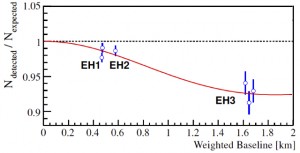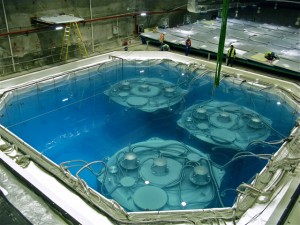Multinational Collaboration Includes Faculty and Students at Illinois Institute of Technology
The Daya Bay Reactor Neutrino Experiment, a multinational collaboration operating in the south of China, today reported the first results of its search for the last, most elusive piece of a longstanding puzzle: how is it that neutrinos can appear to vanish as they travel? The surprising answer opens a gateway to a new understanding of fundamental physics and may eventually solve the riddle of why there is far more ordinary matter than antimatter in the universe today.
Traveling at close to the speed of light, the three basic neutrino “flavors” – electron, muon, and tau neutrinos, as well as their corresponding antineutrinos – mix together and oscillate (transform), but this activity is extremely difficult to detect. From Dec. 24, 2011, until Feb. 17, 2012, scientists in the Daya Bay collaboration observed tens of thousands of interactions of electron antineutrinos, caught by six massive detectors buried in the mountains adjacent to the powerful nuclear reactors of the China Guangdong Nuclear Power Group. These reactors, at Daya Bay and nearby Ling Ao, produce millions of quadrillions of elusive electron antineutrinos every second.
The data revealed a so‑called “mixing angle” named theta one-three (written θ13), which the researchers measured with unmatched precision. Theta one-three, the last mixing angle to be precisely measured, expresses how electron neutrinos and their antineutrino counterparts mix and change into the other flavors. The Daya Bay collaboration’s first result indicates that theta one-three, expressed as sin2 2 θ13, is equal to 0.092 plus or minus 0.017.
“This is a new type of neutrino oscillation, and it is surprisingly large,” says Yifang Wang of China’s Institute of High Energy Physics (IHEP), co-spokesperson and Chinese project manager of the Daya Bay experiment. “Our precise measurement will complete the understanding of the neutrino oscillation and pave the way for the future understanding of matter-antimatter asymmetry in the universe.”
Neutrinos, the wispy particles that flooded the universe in the earliest moments after the big bang, are continually produced in the hearts of stars and other nuclear reactions. Untouched by electromagnetism, they respond only to the weak nuclear force and even weaker gravity, passing mostly unhindered through everything from planets to people. The challenge of capturing these elusive particles inspired the Daya Bay collaboration in the design and precise placement of its detectors. The Daya Bay experiment counts the number of electron antineutrinos detected in the halls nearest the Daya Bay and Ling Ao reactors and calculates how many would reach the detectors in the Far Hall if there were no oscillation. The number that vanish along the way (oscillating into other flavors, in fact) gives the value of theta one-three.
 “What we didn’t expect was the sizable disappearance, equal to about six percent. Although disappearance has been observed in another reactor experiment over large distances, this is a new kind of disappearance for the reactor electron antineutrino.” says Kam-Biu Luk of the U.S. Department of Energy’s Lawrence Berkeley National Laboratory (Berkeley Lab) and the University of California at Berkeley. Luk is co-spokesperson of the Daya Bay Experiment and heads U.S. participation. The first Daya Bay results show that theta one-three, once feared to be near zero, instead is “comparatively huge,” Kam-Biu Luk remarks, adding that “Nature was good to us.” In coming months and years the initial results will be honed by collecting far more data and reducing statistical and systematic errors.
“What we didn’t expect was the sizable disappearance, equal to about six percent. Although disappearance has been observed in another reactor experiment over large distances, this is a new kind of disappearance for the reactor electron antineutrino.” says Kam-Biu Luk of the U.S. Department of Energy’s Lawrence Berkeley National Laboratory (Berkeley Lab) and the University of California at Berkeley. Luk is co-spokesperson of the Daya Bay Experiment and heads U.S. participation. The first Daya Bay results show that theta one-three, once feared to be near zero, instead is “comparatively huge,” Kam-Biu Luk remarks, adding that “Nature was good to us.” In coming months and years the initial results will be honed by collecting far more data and reducing statistical and systematic errors.
Refined results will open the door to further investigations and influence the design of future neutrino experiments – including how to determine which neutrino flavors are the most massive, whether there is a difference between neutrino and antineutrino oscillations, and, eventually, why there is more matter than antimatter in the universe.
“It’s incredibly rewarding after so many years of hard work,” says Christopher White, chair of the physics department and professor of physics at Illinois Institute of Technology (IIT), who serves as a U.S. project manager for electronic readout and data acquisition at Daya Bay. “The quality of the data has exceeded all our expectations. The detectors are working beautifully and we look forward to the possibility of more discoveries yet to come.”
IIT is a collaborating institution of the Daya Bay Reactor Neutrino Experiment. Faculty and students from the university participated in installation and commissioning activities onsite at the Daya Bay Nuclear Power Station in Shenzhen China, as well as contributing to core software and data analysis. Christopher White sits on the technical board and publication committees and chairs the Daya Bay Institutional Board. “Working with our Chinese colleagues has been a wonderful learning experience for us all,” says White. “These initial results open the door to our understanding of why the universe is dominated by matter instead of antimatter.”
“Exemplary teamwork among the partners has led to this outstanding performance,” says James Siegrist, associate director for high-energy physics at the U.S. Department of Energy’s Office of Science. “These notable first results are just the beginning for the world’s foremost reactor neutrino experiment.”
The collaborating institutions of the Daya Bay Reactor Neutrino Experiment are Beijing Normal University, Brookhaven National Laboratory, California Institute of Technology, Charles University in Prague, Chengdu University of Technology, China Guangdong Nuclear Power Group, China Institute of Atomic Energy, Chinese University of Hong Kong, Dongguan University of Technology, Joint Institute for Nuclear Research, University of Hong Kong, Institute of High Energy Physics, Illinois Institute of Technology, Iowa State University, Lawrence Berkeley National Laboratory, Nanjing University, Nankai University, National Chiao-Tung University, National Taiwan University, National United University, North China Electric Power University, Princeton University, Rensselaer Polytechnic Institute, Shandong University, Shanghai Jiao Tong University, Shenzhen University, Siena College, Tsinghua University, University of California at Berkeley, University of California at Los Angeles, University of Cincinnati, University of Houston, University of Illinois at Urbana-Champaign, University of Science and Technology of China, Virginia Polytechnic Institute and State University Blacksburg, University of Wisconsin-Madison, College of William and Mary, and Sun Yat-Sen (Zhongshan) University.

